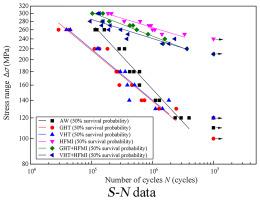Journal of Constructional Steel Research ( IF 4.0 ) Pub Date : 2021-09-03 , DOI: 10.1016/j.jcsr.2021.106933 Zhiwei Gao 1, 2 , Baoming Gong 1, 2 , Yong Liu 1, 2 , Dongpo Wang 1, 2 , Caiyan Deng 1, 2 , Dianjun Hu 1, 2

|
In the study, fatigue tests were conducted to discuss the detrimental effect of local softening induced by post-weld heat treatment (PWHT) on the fatigue behavior of welded joints and subsequent high frequency mechanical impact treatment (HFMI) improvement. According to the distribution of stress and strain by numerical simulation, the difference between fatigue behavior of welded joints with and without PWHT becomes significant with the increase of stress range since the dominant mechanism of fatigue behavior changes from ‘stress-controlled’ to ‘strain-controlled’. The fatigue life of as-welded joints treated by HFMI is longer than that with PWHT+HFMI treatment. In particular, the difference is more obvious with the decrease of stress range due to the difference among the release amounts of compressive residual stress induced by HFMI. The fatigue crack initiation sites are dependent on stress range, local softening effect by PWHT and HFMI treatment.
中文翻译:

PWHT 焊接接头的疲劳性能:焊接状态与高频机械冲击处理
在研究中,进行了疲劳试验,以讨论焊后热处理 (PWHT) 引起的局部软化对焊接接头疲劳行为和随后的高频机械冲击处理 (HFMI) 改进的不利影响。根据数值模拟的应力应变分布,由于疲劳行为的主导机制从“应力控制”转变为“应变-应变”,焊接接头的疲劳行为随着应力范围的增加而显着差异。受控'。HFMI 处理焊后接头的疲劳寿命比 PWHT+HFMI 处理长。特别是由于HFMI引起的残余压应力释放量不同,随着应力幅度的减小,这种差异更加明显。











































 京公网安备 11010802027423号
京公网安备 11010802027423号